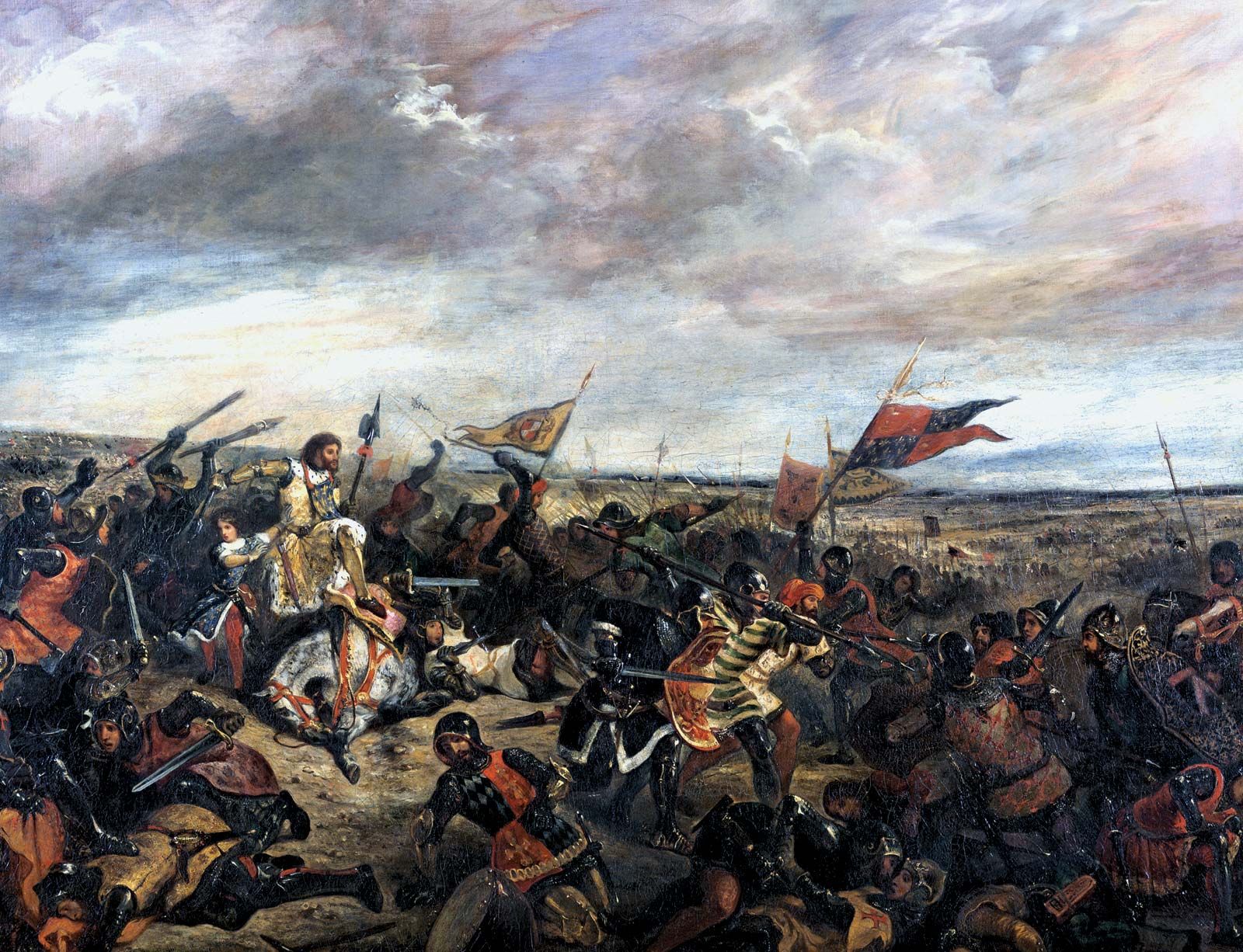On September 19, 1356, the Battle of Poitiers took place in Nouaillé-Maupertuis. It was fought between the Kingdoms of France and England, and is a notable episode of the Hundred Years’ War. Despite the French army’s numerical superiority, the strategy of Edward of Woodstock, the Black Prince, allowed him to secure a decisive victory. At the end of the battle, he captured the French King, John II (known as John the Good), who would remain in captivity until 1360, when he was released following the signing of the Treaty of Brétigny.
The Battle of Poitiers was a turning point in the Hundred Years’ War, weakening the French monarchy and strengthening the British position. It set the stage for later conflict and negotiations.
What Caused the Battle of Poitiers in 1356?

In 1356, the Battle of Poitiers occurred during the Hundred Years’ War, which began in 1337. Several factors contributed to the outbreak of the conflict, such as an economy weakened by the lords’ tax pressures and a demographic crisis, often referred to as the Great Medieval Depression. The origins of the war also stem from the contested succession to the French throne following the death of Charles IV. Additionally, the princely dynasties of the Capetians and Plantagenets fought over the possession of Guyenne (modern-day Aquitaine). Edward of Woodstock, also known as the Black Prince, was required to pledge allegiance to the King of France for this territory.
The Hundred Years’ War did not start favorably for the French. In 1346, the Battle of Crécy resulted in a significant English victory. By 1355, the Black Prince had begun a devastating campaign through Languedoc.
The following year, Charles II of Navarre was captured by the French kingdom, and his family sought help from the English. The Black Prince led his army to rescue him, crossing and pillaging many territories, including Poitou, Limousin, and Berry.
While Edward of Woodstock advanced towards Tours, King John II assembled an army of 50,000 men to pursue him. Aware of the threat, the English retreated toward Bordeaux, passing through Poitiers.
The Key Tactics and Units Used in the Battle of Poitiers
The English army at Poitiers employed a combination of longbowmen and cavalry, which proved effective against the French knights. The use of the longbow played a critical role in the English victory.
Preparations for the Battle
While King John was busy with the troubles in Normandy in April 1356, the Black Prince led an Anglo-Gascon force north from Guyenne. The king mustered his vast army (about 30,000 men) and chased after the fleeing English, hoping to cut off their escape route at Bordeaux.
Maupertuis, located just south of Poitiers, served as the gathering location. The two armies met on September 18, 1356, a Sunday. King John, confident in his triumph thanks to his superior numbers and strategic location, agreed to the Sunday ceasefire requested by the Pope’s delegates.
In an effort to make his army more unified and well-disciplined than the feudal banners, he divided his troops into four distinct “battalions.” The Constable de Brienne, the Marshals of Clermont and Audrehem, and 300 specially picked troops would form the front line and lead the attack to “open and divide the archers.”
The majority of the army fought in two separate battles on foot in the second line, under the leadership of Dauphin Charles and the Duke of Orleans. The “battle of the king,” which included the other French princes, was held in reserve. Equipment for the anticipated foot fight on the 19th was prepared on the evening of the 18th.
Key Characters of the Battle of Poitiers
The French army, consisting of around 50,000 men, was divided into three distinct battalions:
- The first was commanded by Philip of Orléans, the king’s brother.
- Charles of Normandy, the future Charles V, led the second battalion, accompanied by his two brothers, John of Berry and Louis of Anjou.
- The third group was led by King John II himself, along with 19 knights of the Star.
On the English side, Edward of Woodstock, the Prince of Wales, led an army of 1,000 soldiers, 1,500 infantrymen, and around 2,200 archers. He arranged his troops into three lines of defense:
- The Black Prince was at the forefront with John Chandos.
- The second line of defense was commanded by the Earls of Suffolk and Warwick.
- The last was led by the Earls of Oxford and Salisbury.
Battle of Poitiers
The Black Prince’s inner circle made the wise decision to advance ahead of the royal army while hiding in the hedges at the edge of the woods in order to escape the French trap. Captain Jean Chandos was in charge of this strategy.
It was meant to provoke a reaction from the French so that the Welsh archers stationed on the column’s flank might annihilate the aggressor with their longbows.
The fords of the neighboring Miosson would provide safe passage for King John’s army and clear the way to Bordeaux if he withheld his forces. Warwick, Suffolk, and Captain de Buch were in charge of the front-line troops. To guard and advise him, Edward and Chandos commanded the center. Salisbury and Oxford closed the march.
King John wanted the Order of the Star to continue in the spirit he envisioned, so he delivered a powerful speech to its knights. Although the French were successful in the early skirmishes and even captured some Nassau soldiers, the Battle of Poitiers’ official start on the morning of the 19th was a disaster.
The English were marching in accordance with Chandos’ plan, but the French vanguard, unable to keep itself in check, abruptly bolted in opposite directions while the rest of the men remained in camp. “You will not be so bold today that you put the muzzle of your horse to the ass of mine,” said Clermont, who was killed in the assault, to Arnoul d’Audrehem (the Marshal of France). Constable de Brienne made a valiant effort to assault the lagging English column’s rear but was ultimately unsuccessful.
The French troops, while engaged, charged headlong against the English. As a result of this initial victory, the latter group resolved to put up a fight. The archers wiped out the French on foot despite their superior numbers and weaponry.
Despite realizing that his triumph was at risk, the king sent a terrible signal of surrender when he ordered his sons to evacuate and kept just the young Philip with him. But he just couldn’t see himself making the break. Numerous knights abandoned their posts in imitation of the Crown Princes. King Chandos and the Black Prince, the last line of defense from here on out, rush to the front in their turn to launch an assault. Following a fierce hand-to-hand battle, the king surrendered with the future Duke of Burgundy at his side, having been vanquished but maintaining his knightly dignity.
Results of the Battle of Poitiers
The Battle of Poitiers in 1356 was a decisive English victory in the context of the Hundred Years’ War. King John II was taken prisoner, and the English demanded a ransom of 4 million gold écus from France. During the king’s captivity, the Dauphin Charles became the Lieutenant General of the kingdom. He had to face demands from the Estates General, which sought to reform royal power, particularly the administration.
Additionally, the bourgeoisie of Paris attempted to impose their will on the future Charles V. In 1358, he had to deal with a peasant revolt in Île-de-France, Champagne, and Picardy, known as the Grande Jacquerie. The rebellion was brutally suppressed, with over 8,500 people killed in just fifteen days. After this episode, it was not until May 1360 and the signing of the Treaty of Brétigny that King John II was released for a ransom of 3 million gold écus. France ceded a quarter of its territory to the English, including Gascony and Guyenne. In return, Edward III relinquished his claim to the French crown.
Casualties at the Battle of Poitiers
At the end of the Battle of Poitiers, the French army suffered around 8,000 casualties, including 60 barons, an archbishop, and 17 counts. Marshal Clermont and Constable Gauthier VI de Brienne were killed during their assault on the troops led by the Earl of Salisbury. The English lost 340 men, including 150 archers. The most famous prisoner of war was none other than King John II of France.
What Role Did Chivalry Play in the Battle of Poitiers?
The Battle of Poitiers occurred during the era of chivalry, and both English and French knights adhered to chivalric codes. However, the battle also demonstrated that military tactics and technology were evolving and becoming increasingly important in warfare.
Key Dates in the Battle of Poitiers
October 7, 1337 – Beginning of the Hundred Years’ War
On October 7, 1337, the Hundred Years’ War began. Edward III demanded the French crown from his cousin, Philip VI. The conflict also stemmed from a deep economic and demographic crisis.
The war would only end 116 years later, in 1453, with a French victory.
September 19, 1356 – Defeat at Poitiers
The Battle of Poitiers in 1356 was a decisive English victory. The Black Prince, Edward of Woodstock, managed to rout the French army with fewer than 5,000 men. He also captured the King of France, John II “the Good,” along with his son, Philip. After the Battle of Crécy, it was the second major confrontation of the Hundred Years’ War.
March 23, 1357 – Truce of Bordeaux
Established by the kingdoms of France and England, the Truce of Bordeaux marked the end of fighting for a period of one year. The Black Prince sought to use this event to negotiate the ransom of John II “the Good,” but Edward III firmly opposed this. In twenty years, this was the fourth truce of the Hundred Years’ War.
June 9, 1358 – Battle of Mello during the Great Jacquerie
The Great Jacquerie was a peasant revolt that occurred during the Hundred Years’ War. Charles II of Navarre violently suppressed this uprising against the nobility. On June 9, 1358, the Battle of Mello resulted in 7,000 deaths. In the span of fifteen days, more than 20,000 peasants were massacred.
May 8, 1360 – Franco-English Peace of Brétigny
In 1360, the Treaty of Brétigny was ratified by France and England. King John II “the Good” was freed in exchange for a ransom of 3 million gold écus. The Kingdom of France ceded nearly a quarter of its territories. Edward III renounced the French crown. This peace lasted nine years. Charles V broke the agreement on November 18, 1368, leading to the continuation of the Hundred Years’ War.


